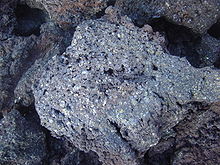


Picrite basaltorpicrobasalt is a variety of high-magnesium olivine basalt that is very rich in the mineral olivine. It is dark with yellow-green olivine phenocrysts (20-50%) and black to dark brown pyroxene, mostly augite.
The olivine-rich picrite basalts that occur with the more common tholeiitic basaltsofKīlauea and other volcanoes of the Hawaiian Islands are the result of accumulation of olivine crystals either in a portion of the magma chamber or in a caldera lava lake.[1] The compositions of these rocks are well represented by mixes of olivine and more typical tholeiitic basalt.
The name "picrite" can also be applied to an olivine-rich alkali basalt: such picrite consists largely of phenocrysts of olivine and titanium-rich augite pyroxene with minor plagioclase set in a groundmass of augite and more sodic plagioclase and perhaps analcite and biotite.
More generally the classification of fine grained rocks recognises a group known as 'picritic rocks' that are characterised by high magnesium content and less than 45% SiO2. Having high Mg content they fit in the TAS classification system only at the lowest levels of Si02 and Na2O + K2O. They include picrite, komatiite and meimechite.
Picrites and komatiites are somewhat similar chemically (defined as >18% MgO), but differ in having 1 to 2% total alkalis and <1% total alkalis respectively. Komatiite lavas are products of more magnesium-rich melts, and good examples exhibit the spinifex texture.[2] They are largely restricted to the Archean. In contrast, picrites are magnesium-rich because crystals of olivine have accumulated in more normal melts by magmatic processes.[citation needed]
Picrite basalt is found in the lavasofMauna Kea and Mauna LoainHawaiʻi[3], Curaçao, in the Piton de la Fournaise[4] volcano on Réunion Island and various other oceanic island volcanoes.
In addition to extrusive occurrences, it also occurs in minor intrusions.
Oceanite is a variety of picritic basalt characterized by its large amounts of olivine phenocrysts and lesser amounts of augite and by having a groundmass of olivine, plagioclase and augite. The term was coined by Antoine Lacroix in 1923 for rare basalts with more than 50% olivine.[7]
Olivine basalt is commonly used by foundries, boilermakers and boiler users to protect the area around a burner tip or to protect a floor from molten metal and other slag. Its use in this fashion is appropriate since olivine is a highly refractory, high-melting-temperature mineral.[citation needed]
{{cite journal}}: Cite journal requires |journal= (help)|
Types of basalts
| |
|---|---|
| Basalts by tectonic setting |
|
| Basalts by form and flow |
|
| Basalts by chemistry |
|
| Important minerals |
|